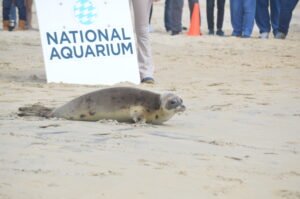
OCEAN CITY – A juvenile harp seal, rescued on Rehoboth Beach earlier this year, was released Tuesday in Ocean City.
Following a weeks-long rehabilitation, a juvenile harp seal, nicknamed Prince, in keeping with the National Aquarium’s current pop icon theme, was released back into the wild this week from the beach at 40th Street.
The marine mammal was admitted to the National Aquarium Animal Care and Rescue Center in Baltimore on Feb. 28 after being spotted in a weakened state on Rehoboth Beach by aquarium colleagues at the Marine Education, Research and Rehabilitation (MERR) Institute in Lewes.
Every winter, seals strand along the East Coast of the United States, according to the aquarium’s rescue center. Seals are semi-aquatic animals, which means they come ashore regularly.
Once a seal on a Maryland beach is determined to be injured or ill, National Aquarium Animal Rescue works with the Maryland Coastal Bays Program and the Maryland Department of Natural Resources to respond.
Officials say Prince was found on Rehoboth Beach in late February, exhibiting signs of dehydration, malnutrition and sea lice. Judging by his 42-pound weight when rescued, the Animal Rescue team was able to determine that Prince was likely born in the Arctic sometime at the end of April 2022.
While at the Animal Care and Rescue Center, officials say they treated Prince for lice and dehydration before taking on efforts to increase his weight. The seal was able to reach a weight of 53 pounds before his release by foraging for and taking 14 pounds of fish a day. To be released back into the ocean, the aquarium reports rehabbed seals must demonstrate they are ready by engaging in enrichment activities, passing medical and behavioral evaluations and weighing at least 50 pounds, the aquarium reports.
Before his release, Animal Care and Rescue staff attached a roto-tag to Prince’s back flipper. This process allows the team to identify Prince if he ever again requires human care and produces a sample of Prince’s DNA, which can be used to help researchers better understand and support the seal species that travel up and down the Eastern Seaboard. In 2022, our animal rescue and animal health teams cared for a grey seal nicknamed Louis Armstrong that was the first seal to receive this special tag at the National Aquarium.
As part of Prince’s rescue, rehabilitation and release, the National Aquarium this week announced the permanent placement of National Aquarium Animal Rescue staff and volunteers on the Atlantic coast.
Under the direction of Stranding Response and Triage Manager Kate Shaffer, a team of volunteers will have an ongoing presence on Maryland beaches where they will be able to quickly respond and react to seal sightings as well as other sea turtle and marine mammal stranding situations.
The aquarium reports the full-time presence will allow National Aquarium Animal Rescue to assist as many animals in distress as possible while eliminating the obstacle of the long commute from Baltimore when responding to precarious animal health events.
As part of the aquarium’s permanent placement, the National Aquarium has partnered with the Town of Ocean City to establish a private animal triage and exam space within the Ocean City municipal complex at 65th Street, allowing the team to assess the needs of rescued animals and establish itself as a reliable partner within the greater Ocean City community.

Onlookers gathered at the 40th Street beach Tuesday to watch as National Aquarium staff released the seal back into the waters of the Atlantic Ocean.
Photo by Bethany Hooper
“We are so excited to have an official presence here on the Atlantic Coast,” Shaffer said. “This region is critical to our work to care for protected and threatened marine species, and being here full time allows us to be more responsive and efficient when time is of the essence. We are grateful to Mayor Rick Meehan, Public Works Director Hal Adkins and members of the Ocean City government for their support in establishing a work site and welcoming us so warmly, and we look forward to making a difference for animals and our neighbors here in this dynamic community.”
Meehan added, “We are thrilled to partner with the National Aquarium and have marine animals treated right here in Ocean City. For the National Aquarium to have an ongoing presence in Ocean City will be highly beneficial for marine life.”
National Aquarium Animal Rescue is federally permitted by the National Oceanographic and Atmospheric Administration (NOAA) and the U.S. Fish and Wildlife Service to respond to sick and injured sea turtles and marine mammals along Maryland’s 3,190 miles of coastline.
Seal rescue season in the mid-Atlantic typically lasts from the early winter through May.
The aquarium said seals encountered on the beach may not be sick, only resting. The aquarium reports observers should not touch or approach the seal, but maintain a distance of 150 feet, note their location and time of day, and immediately contact the National Aquarium’s Stranded Animal Hotline at 410-576-3880.

